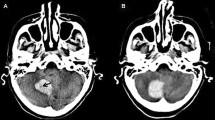Abstract
Background and purpose
Despite extensive studies of supratentorial intracerebral hemorrhage (ICH), limited data are available on determinants of hematoma volume in infratentorial ICH. We therefore aimed to identify predictors of infratentorial ICH volume and to evaluate whether location specificity exists when comparing cerebellar to brainstem ICH.
Methods
We undertook a retrospective analysis of 139 consecutive infratentorial ICH cases (95 cerebellar and 44 brainstem ICH) prospectively enrolled in a single-center study of ICH. ICH volume was measured on the CT scan obtained upon presentation to the Emergency Department using an established computer-assisted method. We used linear regression to identify determinants of log-transformed ICH volume and logistic regression to evaluate their role in surgical evacuation.
Results
Median ICH volumes for all infratentorial, cerebellar, and brainstem ICH were nine [interquartile range (IQR), 3–23], ten (IQR, 3–25), and eight (IQR, 3–19) milliliters, respectively. Thirty-six patients were on warfarin treatment, 31 underwent surgical evacuation, and 65 died within 90 days. Warfarin was associated with an increase in ICH volume of 86 % [β = 0.86, standard error (SE) = 0.29, p = 0.003] and statin treatment with a decrease of 69 % (β = −69, SE = 0.26, p = 0.008). Among cerebellar ICH subjects, those on warfarin were five times more likely to undergo surgical evacuation (OR = 4.80, 95 % confidence interval 1.63–14.16, p = 0.005).
Conclusions
Warfarin exposure increases ICH volume in infratentorial ICH. Further studies will be necessary to confirm the inverse relation observed between statins and ICH volume.

Similar content being viewed by others
References
Broderick JP, Brott TG, Duldner JE, Tomsick T, Huster G. Volume of intracerebral hemorrhage. A powerful and easy-to-use predictor of 30-day mortality. Stroke. 1993;24:987–93.
Dahdaleh NS, Dlouhy BJ, Viljoen SV, et al. Clinical and radiographic predictors of neurological outcome following posterior fossa decompression for spontaneous cerebellar hemorrhage. J Clin Neurosci. 2012;19:1236–41.
Flaherty ML, Tao H, Haverbusch M, et al. Warfarin use leads to larger intracerebral hematomas. Neurology. 2008;71:1084–9.
Ricard G, Garant M-P, Carrier N, Leblanc N, Boulanger J-M. Statins may increase intracerebral hemorrhage volume. Can J Neurol Sci. 2010;37:791–6.
Lou M, Al-Hazzani A, Goddeau RP Jr, Novak V, Selim M. Relationship between white-matter hyperintensities and hematoma volume and growth in patients with intracerebral hemorrhage. Stroke. 2010;41:34–40.
Lee S-H, Kim BJ, Roh J-K. Silent microbleeds are associated with volume of primary intracerebral hemorrhage. Neurology. 2006;66:430–2.
Biffi A, Sonni A, Anderson CD, et al. Variants at APOE influence risk of deep and lobar intracerebral hemorrhage. Ann Neurol. 2010;68:934–43.
Heros RC. Cerebellar hemorrhage and infarction. Stroke. 1982;13:106–9.
Firsching R, Huber M, Frowein RA. Cerebellar haemorrhage: management and prognosis. Neurosurg Rev. 1991;14:191–4.
Broderick J, Connolly S, Feldmann E, et al. Guidelines for the management of spontaneous intracerebral hemorrhage in adults: 2007 update: a guideline from the American Heart Association/American Stroke Association Stroke Council, High Blood Pressure Research Council, and the Quality of Care and Outcomes in Research Interdisciplinary Working Group. Stroke. 2007;38:2001–23.
Biffi A, Battey TW, Ayres AM, et al. Warfarin-related intraventricular hemorrhage imaging and outcome. Neurology. 2011;77:1840–6.
Wojcik NC, Huebner WW, Jorgensen G. Strategies for using the National Death Index and the Social Security Administration for death ascertainment in large occupational cohort mortality studies. Am J Epidemiol. 2010;172:469–77.
Goldstein JN, Fazen LE, Snider R, et al. Contrast extravasation on CT angiography predicts hematoma expansion in intracerebral hemorrhage. Neurology. 2007;68:889–94.
Rosand J, Hylek EM, O’Donnell HC, Greenberg SM. Warfarin-associated hemorrhage and cerebral amyloid angiopathy: a genetic and pathologic study. Neurology. 2000;55:947–51.
Takeuchi S, Suzuki G, Takasato Y, et al. Prognostic factors in patients with primary brainstem hemorrhage. Clin Neurol Neurosurg. 2012. http://www.sciencedirect.com/science/article/pii/S0303846712004477. Accessed 7 Nov 2012.
Matsukawa H, Shinoda M, Fujii M, et al. Relationships among hematoma diameter, location categorized by vascular territory, and 1-year outcome in patients with cerebellar hemorrhage. World Neurosurg. 2012;77:507–11.
Biffi A, Devan WJ, Anderson CD, et al. Statin use and outcome after intracerebral hemorrhage: case-control study and meta-analysis. Neurology. 2011;76:1581–8.
McKinney JS, Kostis WJ. Statin therapy and the risk of intracerebral hemorrhage a meta-analysis of 31 randomized controlled trials. Stroke. 2012;43:2149–56.
Fisher CM. Pathological observations in hypertensive cerebral hemorrhage. J Neuropathol Exp Neurol. 1971;30:536–50.
Amarenco P, Labreuche J. Lipid management in the prevention of stroke: review and updated meta-analysis of statins for stroke prevention. Lancet Neurol. 2009;8:453–63.
Serebruany VL, Malinin AI, Hennekens CH. Statins increase risk of hemorrhagic stroke by inhibition of the PAR-1 receptor. Cerebrovasc Dis. 2007;24:477–9.
Björkhem I, Meaney S. Brain cholesterol: long secret life behind a barrier. Arterioscler Thromb Vasc Biol. 2004;24:806–15.
Acknowledgments
All funding entities had no involvement in study design, data collection, analysis, interpretation, writing of the manuscript, and in the decision to submit for publication. The project described was supported by the National Institutes of Health—the National Institute of Neurological Disorders and Stroke (Grant Numbers R01NS073344, R01NS059727, 5K23NS059774) and the American Heart Association (Grant Number 0755984T). Dr. Brouwers was supported by the NIH-NINDS SPOTRIAS fellowship Grant P50NS061343. Dr. Anderson was supported by the American Brain Foundation.
Conflict of interest
The following authors “Guido J. Falcone, H. Bart Brouwers, Alessandro Biffi, Thomas W.K. Battey, Alison M. Ayres, Anastasia Vashkevich, Kristin M. Schwab, Natalia S. Rost, Anand Viswanathan” have stated that they have no conflict of interest.
Christopher D. Anderson: research Grant from the American Brain Foundation. Joshua N. Goldstein: research Grant NIH—NINDS, Consultant/advisory board CSL Behring. Steven M. Greenberg: research Grant NIH; Honoraria—Medtronic, Pfizer; Consultant/advisory board—Hoffman-La Roche, Janssen Alzheimer Immunotherapy, Bristol-Myers Squibb Company. Jonathan Rosand: research Grant NIH and American Heart Association.
Author information
Authors and Affiliations
Corresponding author
Rights and permissions
About this article
Cite this article
Falcone, G.J., Brouwers, H.B., Biffi, A. et al. Warfarin and Statins are Associated with Hematoma Volume in Primary Infratentorial Intracerebral Hemorrhage. Neurocrit Care 21, 192–199 (2014). https://doi.org/10.1007/s12028-013-9839-9
Published:
Issue Date:
DOI: https://doi.org/10.1007/s12028-013-9839-9




